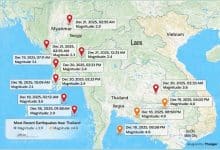Thailand’s tech exports face threats as Vietnam takes lead

Thailand’s export sector, which contributed 54.5% of GDP last year excluding services, faces potential disruption due to rapid technological advancements.
Vietnam has surpassed Thailand in exporting high-tech products, emerging as a key production base for the downstream electronics industry. The global market’s recovery, particularly in computers, semiconductors, and smartphones, has driven this demand.
Thailand mainly exports intermediate electronics products like integrated circuits (IC) and printed circuit boards (PCB). These products, however, face stiff price competition and technological evolution, adding relatively little value.
The Secretary-General of the National Economic and Social Development Council (NESDC) Danucha Pichayanan identified hard disk drives and peripherals as Thailand’s traditional stronghold products.
“While peripherals are still viable, the production of hard disk drives is declining because of technological shifts.I have been saying for years that hard disk drive manufacturing, which shifted to using solid-state technology, has resulted in smaller sizes and the need for chips to control them. This change has led to a decrease in demand for hard disk drives, which are now primarily used in data centres.”
One critical issue has been Thailand’s inability to attract chip manufacturing facilities. These high-tech industries require incentives beyond what the Board of Investment currently offers, including capital subsidies and advanced tools.
Hard disk drive
Danucha stated that about seven to eight years ago Thailand’s hard disk drive industry was doing well.
“As a result, we were not aware of these needs. Now, we must act swiftly.”
To entice high-tech industries, Thailand must not only offer better incentives but also develop a capable workforce. Historically, the country has not produced enough skilled tech workers. However, some universities have started collaborating with foreign institutions to establish chip design centres in Thailand, accelerating workforce training.
Danucha mentioned that the government has enacted laws to enhance competitiveness, but additional funding is crucial. The 2024 budget allocated 16 billion baht for the Competitiveness Enhancement Fund, which has already attracted a few upstream chip and chip design factories to Thailand.
He stressed Increasing financial support for this fund is essential.
A continuous funding mechanism, bypassing the annual budget process, may be necessary to attract critical factories, including battery production plants. The government plans to allocate part of the revenue from the global minimum tax (GMT) to this fund.
The GMT, initiated by the Organisation for Economic Co-operation and Development (OECD), ensures that large multinational enterprises (MNEs) pay a minimum global tax rate of 15% in each country where they operate. If taxes paid are less than 15%, the difference must be paid to the parent company’s home country.
Global tax reform
Thailand, one of the 140 countries that signed the global tax reform agreement, drafted the Top-Up Tax Act, aligning with OECD Pillar 2 principles. The draft law, prepared by the Revenue Department, passed a series of public hearings and awaits scheduling for a Cabinet meeting. If approved, it will take effect from the first day of the year following its publication and is expected to come into force by next year.
Chairman of the Federation of Thai Industries (FTI) Kriengkrai Thiennukul highlighted Thailand’s historical role as a manufacturer in the downstream electronics industry. Major global companies like Western Digital and Seagate established manufacturing bases in Thailand, making it a global hub for hard disk drives.
However, the downstream industry is labour-intensive, and rising labour costs coupled with technological disruptions have significantly affected income from this sector. Kriengkrai noted that Thailand earns only 120 billion baht from the downstream industry, while countries like China and Malaysia with midstream industries earn double that amount.
Kriengkrai said that the FTI is collaborating with the Higher Education, Science, Research, and Innovation Ministry to develop the industry from downstream to midstream, involving higher technology and less labour.
To attract the midstream industry, the government needs to improve infrastructure, create a skilled workforce, and ensure sufficient clean energy.
Foreign direct investment (FDI)
An independent analyst on international economics, Aat Pisanwanich, attributed Thailand’s weakness in developing high-tech industries to its foreign direct investment (FDI) policies. Thailand lacks continuity in its policies and does not require investors to engage in technology transfer.
In contrast, Vietnam has developed a clear roadmap over the past decade, positioning itself as China Plus One. This strategy attracted high-tech industries from the US, China, and Taiwan to establish bases in Vietnam. Vietnam’s stable political environment and enforceable laws, including strict anti-corruption measures, have further boosted investor confidence.
A recent NESDC report revealed that Thailand’s industrial goods production declined for six consecutive quarters, reported Bangkok Post.
Export production for key products like electronic components and circuit boards dropped significantly, contributing to a 1% decrease in Thai goods exports in the first quarter this year.
Latest Thailand News
Follow The Thaiger on Google News:


























